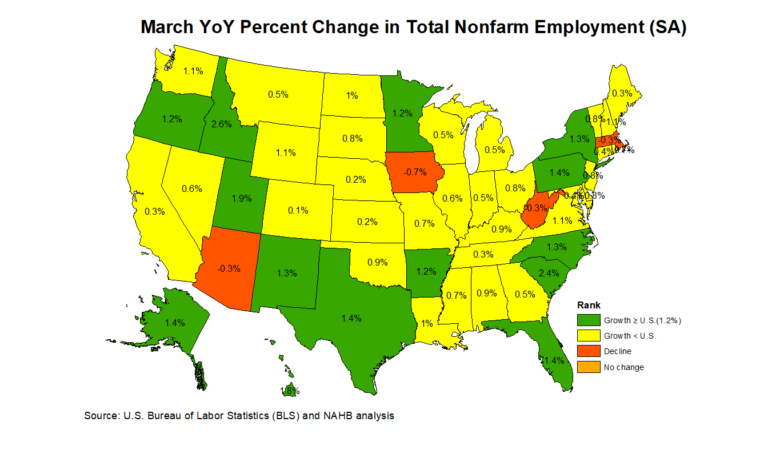The housing market may be at greater risk than many of us thought. An economic trifecta is forming. If all three conditions hit at once, it could spell serious problems for anyone in the real estate industry. We may be close to a time when high home prices, high mortgage rates, and a recession all meet, causing a significant slowdown with effects that could hurt everyone who buys, sells, or helps transact on homes. But how likely is this to happen?
The past month has been a wild ride for the economy. Mortgage rates fell dramatically but are now shooting back up. Inflation and unemployment fears are peaking as consumer confidence drops to unprecedented levels. And now, new tariffs could drive costs even higher. This could change everything, weakening the US dollar and making buying a house even harder.
Every real estate investor, agent, lender, or professional should understand these risks because the effects could be severe. In this episode, we’re breaking down all the latest economic changes and how they affect the housing market.
Click here to listen on Apple Podcasts.
Listen to the Podcast Here
Read the Transcript Here
Dave:
There’s a trend in the economy right now, a potentially concerning one that could significantly impact real estate markets. And although this story is still developing, I think it’s important to talk about it now so we can all stay ahead of the curve today. We’re going to unpack the wild few weeks that we have all just been through and how the potential impacts on the housing market have me a little concerned. Hey everyone, it’s Dave head of real estate investing at BiggerPockets. I will be honest with all of you, I have been absolutely glued to my computer the last few weeks following every economic update, refreshing my browser every two minutes. There’s just been so much to follow and to be honest, it’s hard to make any definitive conclusions about what it all means, what’s going to happen next because conditions are just changing so continuously.
But there are a few things that have happened which may have flown under your radar that could potentially impact the real estate market. And I am a little bit concerned about some of these things. I’m not running for the hills or anything like that, nor is it anything that is definitive right now. But let’s just say that there have been some new risks that have been introduced to the housing market and there are things that we should be talking about. So that’s what we’re going to do today. We’re going to get into this, but please just remember this is an emerging trend. It’s nothing definitive. I just feel like it’s important to share with you what I am thinking about and what I see as some increased risks that real estate investors should be thinking about. Alright, so you probably all know the big picture, what’s going on.
Everyone knows there have been tariffs that are on and off and it’s hard to know what happens from here. They’re probably going to go on, they’re probably going to go off from what we hear from the Trump administration. There’s going to be ongoing negotiations with a lot of trade partners. And so my expectation is at least for the next 90 days during this pause and maybe even after that, we’re going to have changing conditions with tariffs. And I know everyone’s probably super tired of hearing about tariffs right now, but it really does matter how these wind up the size of tariffs on which trading partners will really impact the whole economy and they are going to impact real estate investors in ways that may not be obvious. I think people understand construction materials might be going up, but there’s a lot more to it and that’s what we’re sort of going to dive into over the course of this episode.
But amidst a lot of these wild swings that we saw in the stock market, which were of course making all the newspapers and cable TV shows, and that was getting a lot of attention. Something else also happened, and you may have noticed this, but mortgage rates, they originally went down, but they actually went up last week and I’m recording this on April 15th, so I’m talking about one week ago unexpectedly mortgage rates started going back up and you’re probably thinking, yeah, so what? Right? I mean mortgage rates are changing all the time. They are super volatile right now and that is true. But the timing and the reason that they went up are a little bit different and that is really what matters. And that is what has me paying extra close attention to mortgage rates right now. And yeah, I look at mortgage rates every single day, but I pay even closer attention because I think this is super important for the housing market because we all know this, we’ve seen this for the last few years, but high rates happen, right?
They’ve been elevated since 2022 and even despite that, I’ve personally never thought there was going to be any sort of crash. I’ve never predicted any sort of crash. I know this year I’ve said prices were going to be flat, maybe a mild correction, but I think I’ve taken those high rates in stride as has the housing market. In addition, the housing market has also taken high prices in stride. People say, oh, what goes up must come down. That is definitely not true in asset values. And high prices can actually be sustained under the right conditions, which is what we’ve seen for the last three years and over the last few weeks fears and the probability of a recession has gone up, and we’ll talk about that more and recessions are terrible. No one wants these things, but they’re not always bad for the housing market because in fact, actually home prices have grown in four of the last six recessions.
But what has me concerned is the combination, right? If we have high rates with a recession and high prices, that could put downward pressure on the market If we have a recession, and I’ll just tell you guys, I think that is likely, and I’ll give you some reasons for that in a little bit, but I think a recession is more likely than not at this point. And we have high rates that stay high because we just saw rates go back up. That could mean that prices decline more at least than I thought they would in the beginning of the year. Not saying that’s going to be a crash but more downward pressure than I was expected. So that’s what is worrying me or what I was alluding to at the top of the show is that there is a higher probability, at least in my mind, that we’re going to have this combination of high rates, high prices and a recession.
So the question is could this actually happen and why right now, am I just bringing this to your attention or why am I starting to think about this just over the last couple of weeks as a refresher? I just need to do this quickly. I know if you listen to the show, you’ve heard this before, but let’s just talk about mortgage rates and how they move and the fundamentals here. Mortgage rates are tied to bond yields, most specifically, they’re tied to the yield on a 10 year US treasury, which is just a form of government bond when bond yields go up. So do mortgages when bond yields go down, so do mortgage rates. So those are the basics, but we need to talk about why yields go up and down if we want to understand this concern that I have and what’s going on with mortgage rates.
So the first thing that can drive up mortgage rates is inflation. Inflation, just generally speaking, not always, but pretty much almost always inflation tends to push up bond yields because bond investors, the people who lend money to the government, they are super worried about inflation because when you buy a 10 year US treasury, basically what you’re doing is you’re giving the government your money for 10 years and in exchange they’re going to pay you some interest rate. It’s sort of like a high yield savings account. It works in much the same way. And right now the yield or basically the interest that you earn on that bond is about 4.3%, which is pretty solid, right? It’s not bad. It’s way better than bond yields were over the last decade or so. But if inflation is 3% like it is right now, when you calculate your real return, you take your interest rate that you’re earning minus the rate of inflation, you’re getting about a 1.3% real return that isn’t terrible, but that’s basically what you’re getting.
But the concern for bond investors is I’m lending the government money for 10 years. What happens if half of that time when I’m lending money to the government, inflation goes up above 4.3%? What if it goes to 5% and I’m locked in lending the government money at 4.3%? That means in real inflation adjusted returns, I’m losing money. And so this is one of the main dynamics that happens in the bond market. When people are afraid of inflation, they demand a higher interest rate to lend money to the government. Now just last week we got some inflation data that was actually pretty encouraging. I was super happy to see that inflation came below expectations, which is great, but the reason people are afraid of inflation right now is not what’s happened over the last couple of months. This is data from March. So we’re not super concerned about that because what’s driving inflation expectations or fears right now is tariffs.
Tariffs. Whether you agree with them or disagree with them historically, you can’t really argue this. Historically, tariffs have caused inflation and there is really no reason that I have seen to think that this time is going to be any different. Prices will probably go up, and even Trump and his team have said this. They have said that there could be some short-term pain in service of their long-term goals. And the short-term pain I think they’re largely referring to is likely inflation. Because remember, tariffs are taxes and they are taxes paid by American companies for importing goods. And when American companies have to pay more money to import a TV or to import a t-shirt or lumber, whatever it is, they often pass those prices onto consumers and that pushes up prices and that makes inflation go up. And we don’t know exactly what will be hit hardest or to what degree, but I think it’s safe to assume that we are going to see some level of inflation increases.
Imports are definitely going to go up. Anything that’s imported that now faces at least a 10% tariff, if not, depending on the good or the country it comes from, we’re going to see prices go up on those. And historically we also see the prices on domestic products go up as well. And I know this one can be confusing because a lot of people say, oh, if you just buy American, you won’t face inflation. That’s not always the case because they’re sort of two dynamics here that could continue to push up prices. Even for things that are manufactured here in the United States, the first is less competition. This is sort of one of the principles of a free market is that the more competition you have, the lower prices go. And so if tariffs make imports prohibitively expensive, that gives American manufacturers and producers sort of some room to raise their prices because they know that we as consumers can’t go out and buy an imported good because that has gotten more expensive.
That has happened a lot of times in history when there have been tariffs, and I think it is safe to assume that some level of that is going to happen here as well. The second thing is we are in such a globalized economy that the idea that anything is truly made in America entirely is pretty rare. There are definitely some examples of this, don’t get me wrong, but if you think about cars that are made from America, a lot of those parts are still imported from elsewhere. Maybe that steel or aluminum that is used to make those cars is imported, which now has a 25% tariff on it. So even if it’s assembled here in America, a lot of the raw materials or the inputs to those materials are going to be tariffed and that could push up prices or perhaps the machine that helps you assemble that car is made in another country and importing the robotics or the computers that help those manufacturers that are operating in the US run those items are going to get more expensive too, and some of that is very likely to get passed on to consumers.
So all that to say people are worried about inflation and that’s probably one of the reasons yields went up last week. And again, it’s not crazy. It’s not like yields went up way past where they have been, but normally during a week where we saw a stock sell off and a lot of uncertainty, you’d expect bond yields to go down. That is the normal thing that would’ve happened. But instead we saw them go up and my expectation is at least one of the factors here is that fear of inflation. There is a second thing that’s been going on here though that might not be as obvious and is a little bit unusual because we’ve known about the inflation fear, right? We’ve been talking about this for six months. So I don’t think that’s what really has changed and sort of changed my perception of what’s going on in the housing market. Instead, there is sort of this second thing that may have flown under your radar. I will get to that, but first we have to take a quick break. We’ll be right back.
Welcome back to On the Market. I am here talking about some shifting dynamics in the housing market that I think has introduced a couple of new that everyone needs to take into account. And again, I’m not panicking or anything like that. I’m just trying to share with you things that are on my mind and you can do with this information, whatever you want. Before the break, I mentioned inflation and that was one reason that I have some growing concerns that rates could stay high even if we go into a recession and I want to make clear that that is abnormal. Normally when there is economic uncertainty or there is a recession, what happens to bond yields is that they go down and they take mortgage rates down with them. And this happens because bonds are generally seen as a safe haven lending money to the government.
Specifically the United States government is seen by almost all investors across the world as the safest investment that there is. That has been the opinion. And so when the stock market starts to look a little bit frothy or people get a little bit nervous about cryptocurrency or whatever it is, they say, you know what? I’m going to take some risk off the table. I’m going to sell some stock. I’m going to put it in the bond market because that’s super safe and it’ll help me ride out this uncertain period. When that happens, when more people want these treasuries, that increases demand for US government bonds. That means a lot of people want ’em, and that means the government can say, you know what? So many people want to lend us their money. We don’t have to pay you 4.3%, we’ll pay you 3.8% and that’s good for the government.
That lowers our debt service payments on all of our very substantial debt here in the United States. And that is why when there is a recession or there’s fear of a recession, generally speaking, bond yields go down, mortgage rates come down as well. But that is not what happened last week, right? Last week, yeah, stocks went back up one day they went down, but we had this massive uncertainty. The stock market is still lower than it was before the liberation day announcements. We had banks calling for recessions, we had all sorts of economic uncertainty in these kinds of situations. Historically, if you look at weeks like the one that we had last week, yields normally go down because investors, like I said, would be fleeing these riskier assets and putting their money in the safe haven of US treasuries, but yields went up. So why did that happen and why does it matter?
Why is this freaking me out a little bit, right? Because bond yields go up and down all the time. We saw three things happen altogether, and this was prior to Trump’s announcement of the pause. So I want to separate the timelines here because the first half of last week we were seeing broad, broad stock market declines. We also saw yields going up at the same time. That’s what was really concerning me. And we saw the dollar start to get weaker. And on Wednesday this was starting to get gritty intense. And I was watching this really closely and I think a lot of people believe that one of the reasons that Trump paused the tariffs for 90 days was because we were starting to see bond yields go up, which could be a really problematic thing for the entire financial system. And this can get technical.
We don’t have to get into all this, but it was basically a sign in general that investors did not have the same appetite for US assets and that can be a problem. They were basically all at the same time saying that they don’t want the US dollar, they don’t want US treasuries and they don’t want stock assets equities in the United States at the same rate that they did a couple of weeks ago. And we’re basically seeing capital leave the country. And so whether you believe that Trump pause the terrorist for this reason or not, either way, I think this was really concerning. And once the pause happened that reversed right bond yields have started to come down and they’ve been a lot more stable. They’ve actually started to come down a little bit more this week as well, which is reassuring me a little bit.
But this was so unusual and concerning that I do still just want to talk about this because whether it’s retaliation from other countries for the trade war or people seeing better growth opportunities in Europe or in Asia, if demand for US treasuries for whatever reason it is, if there is less demand for US treasuries, that means that borrowing costs are going to get higher in the United States, and this is independent of what the Fed does, this is independent of a lot of policy decisions. They can do stuff to sort of alter people’s demand, but if demand goes down and stays down, that is going to mean higher borrowing costs for the US government, which is not a great thing for the government budget because we already have so much debt, but it also translates to higher borrowing costs for ordinary Americans. And for us as real estate people, that means higher mortgage rates.
And I know this small shift in what happened in bond yields last week, it may not seem like a huge deal, but I really believe that everyone, I’m definitely going to be looking at this, needs to keep an eye on demand for treasuries over the next couple months. This is going to be hugely important not just for this year and not just for mortgage rates, but really for the next several years of the economy because regardless of what you think of trade policy and tariffs and all that, there is an inescapable truth. The United States right now still enjoys an extremely favorable position in the global economy because we have the world’s reserve currency. This makes the dollar very strong. It lowers the cost of imports for US companies and consumers, and it makes our debt very attractive. Investors all over the world want to own US debt because it is seen as safe and stable and all this demand because investors from all over the world want to own US debt that drives down our borrowing costs.
That is one of the reasons why we have bond yields as low as they are, why we’ve had mortgage rates that are lower than we see in a lot of countries. One of the reasons perhaps we can have a third year fixed rate mortgage when that is very unusual in other countries because remember what I just said, when there are lots of investors who want to buy US debt, it means the government can pay a lower interest rate that sets the floor for lending throughout the entire economy. And that means we have lower mortgage rates. And if that demand decreases in any sustained way for whatever reason, borrowing costs will go up for the entire US economy on average. That doesn’t mean that there’s not going to be fluctuations, there definitely will be if the fed cuts rates, there will still probably be a decrease in rates, but it means our baseline borrowing costs could start to go up.
Now again, it is too early to tell if this is a pattern and if there’s going to be sustained lower demand, but what happened last week did raise the question of whether or not investors are going to have less appetite for US debt in a world that might be deglobalization. So as I said at the beginning, the thing that I think is important to remember here is that I’m not saying that there’s going to be crash or anything like that. Bond yields are sort of starting to move in another direction, but I think whether it’s because of this lower demand for treasuries or the fear of inflation, the risk that we will have a recession, which I believe is likely and higher rates is going up a little bit. Now, let’s talk a little bit about recession. No one knows for sure what’s going to happen and there is no official definition of a recession.
I know people use two consecutive quarters of GDP growth. That would be a lot easier. I wish we just had a simple definition, but we don’t here in the United States. Instead, we have a group of academics who make this decision in retrospect. And so even if we’re in recession right now, we won’t know it for several months. So the term has almost become meaningless. But when I talk about a recession in this episode, what I’m saying is I do think there is a good chance that we see GDP growth, which GDP is gross domestic product. It’s the total economic output of the country. I think there is a good chance we see at least one quarter of GDP declines this year, if not two. And there’s a lot of reasons for that. First, Trump himself has said that there is going to be some pain economic pain as these tariffs go into place, and I agree with him on that point.
We’ve seen consumer confidence and sentiment really start to decline, which can be an indicator that consumer spending will decline. That’s 70% of GDP, so that’s enough to put us into a recession. We’re starting to see some trends like tourism going down to the United States. Just today, China announced that they’re putting a halt to buying all Boeing planes. And I know that’s just one example, but I actually think that by dollar amount, Boeing is the biggest exporter of goods in the United States. So these things, they’re just anecdotal things, but we’re making huge, enormous changes to the economy, and there is going to be at a minimum some period of transition, and I think it’s very likely that that period turns into at least some decline in GDP, whether it’s one quarter, two quarters, I don’t know. But I think that decline is likely, and as I said at the beginning, no one wants a recession that is bad for everyone, but it’s not necessarily a case where housing prices are going to go down or vacancies are going to go up. There’s actually a lot of mixed data on that. So a recession alone wouldn’t give me cause for concern specifically about the housing market. But I do want to share with you why I think if we go into a recession and mortgage rates stay higher for either of the two reasons that I mentioned before, it could put more downward pressure on the housing market. We’ll get to that right after this break.
Welcome back to On the Market. I’m Dave Meyer here talking about some new risks that have been introduced into the housing market, at least as I see them. And as I said, I think there’s a chance that mortgage rates are going to stay a little bit higher than even I was expecting. I said at the beginning of the year, I didn’t think they were going to go down that much, but I was expecting that if we went to a recession that they would start to go down. I just thought at the beginning of the year, a recession wasn’t as likely. Now, I think that a recession is the most probable case. It’s not for certain at all, but I think it’s the more likely scenario that we see recession or negative GDP growth at some point in 2025. But as I mentioned, I am not as convinced that mortgage rates will go down if that happens, and that could have two substantial impacts on the housing market.
So if that happens, if we have this combination of recession and higher mortgage rates, I think it has two big economic implications, one for the housing market and just one for the economy as a whole. First and foremost, let’s talk about the housing market. So we all know this, mortgage rates are relatively high right now. They’re back up close to 7%, and this is just coming at a really bad time. Normally this period of April and May is the high season for buying and selling of real estate. And right now, because of all the economic uncertainty, even though we don’t know if we’re in a recession or GDP decline, this economic uncertainty, I have some concerns that it could reduce buyer demand. A lot of people might just choose to wait and see what happens over the next couple of months before making a big financial decision.
We see this in the fact that consumer confidence is down. We see data that inflation expectations are up. We see data that unemployment expectations are up. And so put yourself in the shoes of the average home buyer, average person who’s trying to get into the real estate market. If you had less consumer confidence, if you think inflation’s going up and probability that you’re losing, your job is going up, you may choose to sit out the normal busy home buying season, and this will be not great for housing prices or sales volume, right? Inventory is already rising, and if demand dips, I think there’s a good chance housing prices turn negative at some point this year on a national basis, and I don’t think that’s going to be a crash, but earlier in the year, I’d said, I think prices are going to be flat plus or minus 3%, right?
They could be up 3% at the end of the year. It could be down 3%, but they’re going to be somewhere close to flat. I would shift that down a couple of points if we go into recession and rates stay as high as they are now, there’s some caveats around that, but that’s sort of what I’ve been thinking about is this is something that could have me revise forecasts a little bit downward. So that’s one thing to remember. And then the second thing, if you’re a real estate agent or you’re a loan officer, I think everyone’s been sort of hoping and counting on a recovery in sales volume, right? We are at 50% below where we were in 2022 in terms of total home transactions, and most people, myself included, had been projecting modest growth in the total number of home sales. But if rates stay near where they are and we go into a recession or there’s this sustained level of economic uncertainty, I don’t know.
I think we might remain at really low transaction volume, which is just bad for the whole housing industry in general. So that’s just one thing to keep in mind. The second thing is if we do go into a recession and rates stay high, let’s say in the sixes, it could actually elongate or worsen that recession because recessions are tough for everyone. But normally what happens, like I said before, normally mortgage rates and borrowing costs across the entire economy go down during a recession, and this creates this sort of, they call it the first in first out model of real estate and recessions, because when interest rates go up, real estate’s usually the first thing that’s hit. Transaction volumes go down, prices get a little bit softer. We’ve seen that. But then when the economy in general starts to falter, mortgage rates come down and that brings some people in off the sidelines.
I know that’s not so intuitive, but that often happens even in a recession when mortgage rates start to come down. Some people come in off the sidelines, and that stimulates not just the housing market, but it can stimulate the entire economy. Housing is about 16% of GDP, and so housing is strong enough. It is a big enough industry, it is a big enough driver of economic output in the United States to pull the entire economy out of a recession. And so my fear is that if mortgage rates don’t come down that much, that we might stay in a recession longer than we would if mortgage rates went down in the way that they normally do. So the question of course, is this going to happen? And I think it’s too early to say that. I still don’t think this is the most probable case. I think that we will probably go into a recession, but I do think mortgage rates will fall with that.
That is sort of still my base case here because I do think that the Fed will lower rates if we start to see the market start to contract, but if inflation stays high, they might not. So that is the number one concern. The other thing is that the Fed could lower the federal funds rate and bond yields might not fall. That doesn’t normally happen, but I think after what happened last week, we have to at least entertain that. It is a possibility, even though, again, I just want to reiterate this. I don’t think it is the most probable scenario. I wanted to just share this all with you because it has been on my mind, and I think my role here as the host of on the market is I’m analyzing this data all the time, and there’s a new trend emerging, something that I think is important, something I’m going to be keeping an eye on. And although I’m not panicking about this, I’m still looking at real estate deals for sure. It is something I’m probably going to be talking about more over the next couple of months. So I wanted to let you know what’s going on here so you could stay ahead of the curve. I just want to make sure that you guys, no, I’m not trying to scare anyone. I’m not trying to be sensationalists.
There’s a good chance, I think there’s a better chance than not that these things don’t come true. I’m not saying that there’s going to be a crash. I just think that it’s important to talk about these trends as soon as they start to emerge. But as I said, I don’t think this is a reason you can’t necessarily look at real estate. It really sort of depends on your perspective, because I am saying that I think the chances that the market gets soft go up, and that might scare people. Or if you own a lot of real estate, you might be a little concerned about property values. But again, I think this might be a slight correction. I’m not saying that there’s going to be a crash, but on the other hand, it means that there’s probably going to be more buying opportunities if prices go down, that means that affordability could get a little bit better, and that can open up a lot of opportunities for real estate investors.
So I’m not saying that this is necessarily a bad thing. Again, I’m not saying this is catastrophic. I’m not running for the hills. I just want to share with you what’s going on so you can make informed decisions, and maybe you can even impress some friends when you start talking about bond yields. That’s all I got for you guys today. Hopefully this is helpful to you. I’d be very curious to learn whether, if you’re watching this on YouTube, drop it in the comments or just hit me up on Instagram. I’d like to know if you think this is helpful to you, because as I said, I don’t want to be sensationalist, but I do think it’s sort of my job to share with you when things start to change or when new risks or new opportunities enter the housing market. And this is a good example that I wanted to share with all of you. Thank you all so much for listening to this episode of On The Market. I’ll see you next time.
Watch the Episode Here
Help Us Out!
Help us reach new listeners on iTunes by leaving us a rating and review! It takes just 30 seconds and instructions can be found here. Thanks! We really appreciate it!
In This Episode We Cover
- New risks to the housing market that could cause big changes for buyers and sellers
- Why interest rates are starting to reverse, shooting back up EVEN with high recession risk
- The trifecta of bad news for the housing market and what investors must know now
- What a weakening dollar means for mortgage rates and the US economy as a whole
- Transaction volume forecasts and whether we’ll still see a hot spring homebuying season
- And So Much More!
Links from the Show
Interested in learning more about today’s sponsors or becoming a BiggerPockets partner yourself? Email [email protected].

















Kitchen at a Glance
Who lives here: A couple
Location: Leicestershire, England
Size: About 140 square feet (13 square meters); about 16 by 9 feet
Designer: Matt Fern of deVOL
Simple, honest materials, open cabinets and rich copper details combine to make this farmhouse kitchen feel warm and welcoming.
“It’s a classic Victorian staff kitchen in many ways — the open shelving, butler’s sink and scaffold-board [countertops] are all simple, functional features of an honest, hard-working space,” designer Matt Fern of deVOL says.
Materials were key in this project and copper and brass both feature heavily. “It was important that it wasn’t fussy or too polished,” he says. “It was important that it wasn’t fussy or too polished. They wanted a rustic farmhouse look with the emphasis on functionality,” Fern says.
Open cabinets were a careful design choice to create a warm, practical feel to the kitchen. “It’s an unashamed reflection of a working farmhouse kitchen, with all the pans on display where they’re close at hand,” Fern says.
“People are often reluctant to go for open cabinets, saying they’re just not tidy enough, but this couple embraced the idea, which was really refreshing,” Fern says. “They’re a good way to show your personality, whether you display decorative pieces or more functional items, such as colanders and crockery.”
9 Green Paint Colors to Consider for Your Kitchen